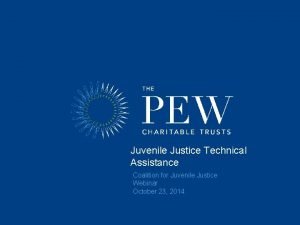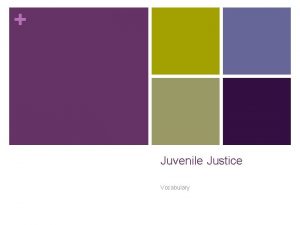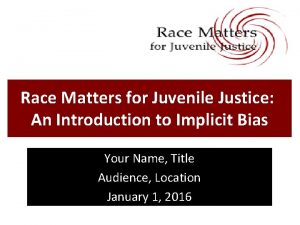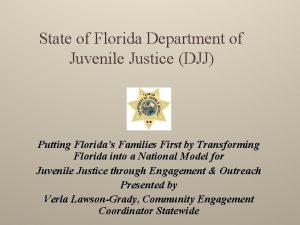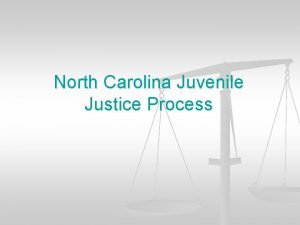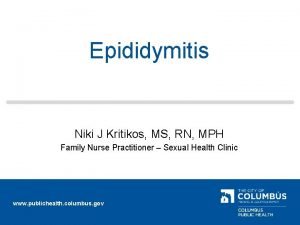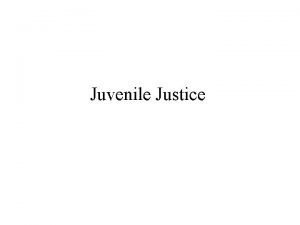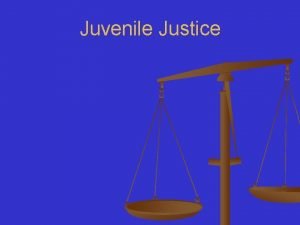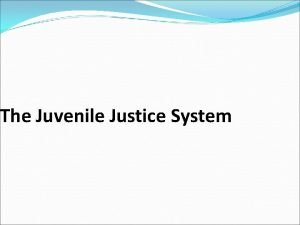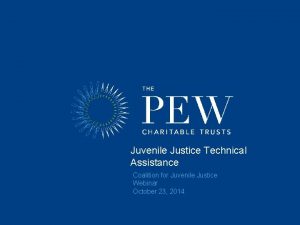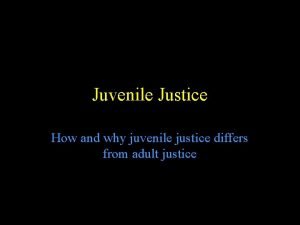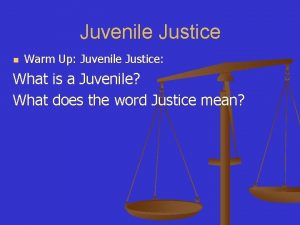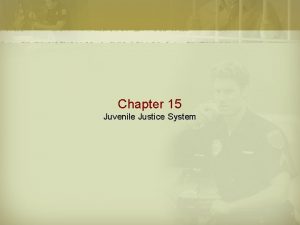Current Issues for Girls in Juvenile Justice Niki














- Slides: 14


Current Issues for Girls in Juvenile Justice Niki Miller, M. S. , CPS Senior Project Associate Advocates for Human Potential, Inc. nmiller@ahpnet. com 2

Improving the Juvenile Justice System for Girls: Lessons from the States (Oct. 2012) By Liz Watson and Peter Edelman Georgetown Center on Poverty, Inequality and Public Policy 3

Policy Series on Marginalized Girls: Partners and Supporters This report is a product of the policy series, Marginalized Girls: Creating Pathways to Opportunity, hosted by the Georgetown Center on Poverty, Inequality and Public Policy, in partnership with The National Crittenton Foundation, and the Human Rights Project for Girls. The Atlantic Philanthropies The Annie E. Casey Foundation The Open Society Foundations’ Special Fund for Poverty Alleviation 4

Elements of the Report • Review of literature on girls pathways to Juvenile Justice • Brief history of reform efforts • “Case studies” of reforms in two state systems (CT, FL) and one county (Stanislaus County, CA) • Steps involved in actuating reforms • Federal policy recommendations to support state and local efforts 5

Context of Growing Numbers of Girls Entering the System • • • Girls are low risk, high need (little risk to public safety, but need intensive levels of services if they are to make it) More likely to be detained for non-serious offense than boys; status offenses and technical violations account for 41 % Still less than 10% of arrests for violent crime. Already fastest growing group; poised to expand; now 15% of juveniles in residential placement Increases in girls’ arrests for assaultive crimes appear to be mostly due to policy changes and other factors – Low level interfamilial altercations are re-classified as domestic violence – Unavailability of diminishing community-based programs – Lack of diversion options; need for gender responsive probation – Zero tolerance school policies – Up to 70% of time, inadequate parenting is a factor 6

Prevalent Characteristics • Poly victimization, violent and sexual victimization; within family and from others - significant needs related to trauma • Parental incarceration; death of parent or sibling histories • Instability – 30% have moved 10 times or more • Past pregnancies; 16% pregnant while confined, teen moms • Multiple physical health problems; early school failure • Runaways; family conflict; separated or estranged from family • Parental substance addiction; childhood neglect 7

Office of Juvenile Justice and Delinquency Prevention (OJJDP) • OJJDP has supported development of specialized gender-specific programs ranging from prevention to detention. In 1998 the agency awarded challenge grants to 25 states to develop these capacities. • OJJDP chronicled the reform efforts and developed gender-responsive guidelines: – Programs should be all female whenever possible; – Girls should be treated in the least restrictive environment, whenever possible; – Programs should be close to girls’ homes in order to maintain family relationships; – Programs should be consistent with female development and stress the role of relationships between staff members and girls; and – Programs should address the needs of parenting and pregnant teens. 8

OJJDP Resources on Girls • OJJDP created the Girls Study Group: http: //girlsstudygroup. rti. org/ • Published Guiding Principles for Promising Female Programming: An Inventory of Best Practices, which highlights exemplary and effective gender-specific program practices that States and local jurisdictions can use immediately. 6/13/2021 9

Almost Universal Agreement Among Reformers • Girls should not be tried as adults or in adult facilities • Girls (and boys) should not be detained for status offenses • As budget cuts to community programs ensue, more girls will enter the juvenile justice system • Substantial investment into gender- responsive, trauma-informed front end diversion and community supervision programs is needed 10

“Architecture” of Reform Process The report chronicles impressive reform in the CT, badly needed reform in the Florida system and innovative reform at the local level in Stanislaus County, CA. Although the communities took very different approaches, the steps that follow were necessary. • Research to Diagnose the Problem (including listening to system-involved girls) • Public Education Campaign • Strategic Planning • Engagement of Key Stakeholders, including Girls • Legislation • Staff Training • Community-Based Diversion and Prevention Programs • Pilot and Demonstration Projects • Outcome Measures and Evaluation • Technical Assistance • Funding and Sustainability

Federal Policy Recommendations to Support State and Local Reform The report includes federal policy recommendations. Noting that federal policy can often seed state and local gender-responsive reform efforts. • Conduct and Fund Research and Evaluation • Develop and Promote High-Quality Assessment and Data Collection Tools for Girls • Encourage State Advisory Groups to Focus on Gender-Specific Programming • Train Judges, Law Enforcement, and Juvenile Justice Staff • Encourage Use of Federal Funds to Promote Gender-Responsive Reform Efforts

Federal Policy Recommendations to Support State and Local Reform continued • Convene Interagency Working Groups at Federal and State Levels to Address the Needs of Marginalized Girls and Young Women • Eliminate Valid Court Order Exception for Status Offenders • Ban Shackling for Pregnant Girls • Monitor Compliance with the Prison Rape Elimination Act and its Implementing Regulations • Encourage the Development of National Standards for Gender. Responsive Programming 13

Questions? Comments? What would like to hear more About? Thank you for your work on behalf of women and girls. 14
 Coalition for juvenile justice
Coalition for juvenile justice Cottage reformatories
Cottage reformatories Juvenile justice act 2000
Juvenile justice act 2000 Race matters for juvenile justice
Race matters for juvenile justice Minnesota juvenile justice system
Minnesota juvenile justice system State of florida department of juvenile justice
State of florida department of juvenile justice North carolina juvenile justice
North carolina juvenile justice Unit 2 criminal law and juvenile justice
Unit 2 criminal law and juvenile justice Juvenile justice alternative education program
Juvenile justice alternative education program Juvenile justice system in georgia
Juvenile justice system in georgia Republic act 9344
Republic act 9344 Juvenile justice system georgia
Juvenile justice system georgia Niki kritikos
Niki kritikos Niki lukviarman
Niki lukviarman Actiefase
Actiefase
